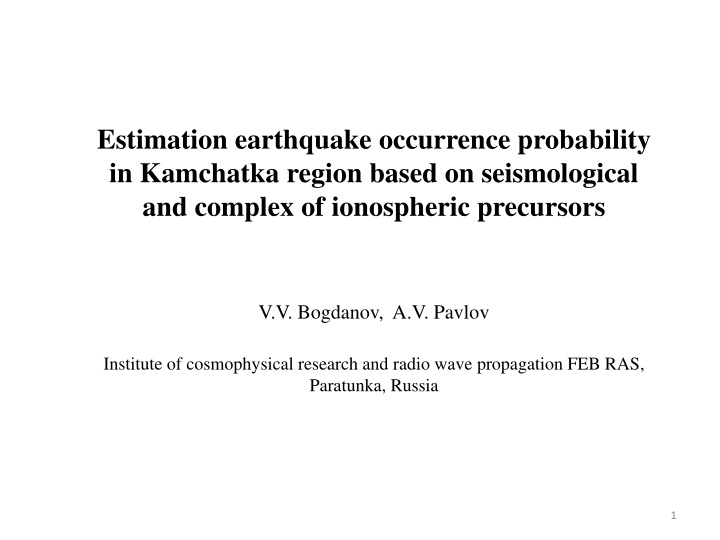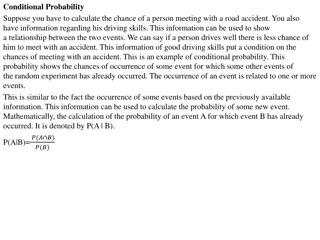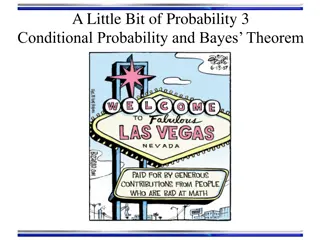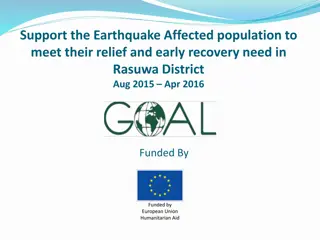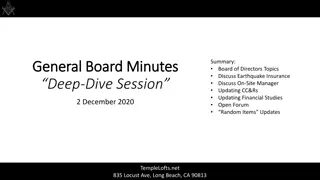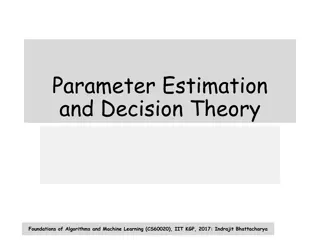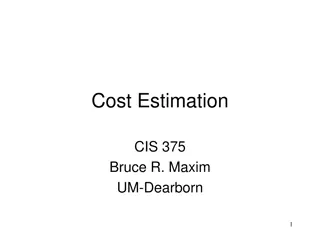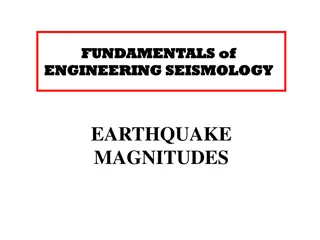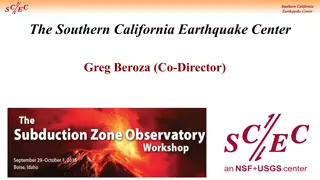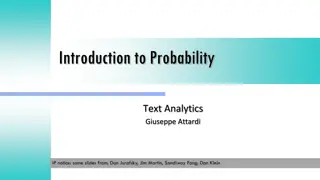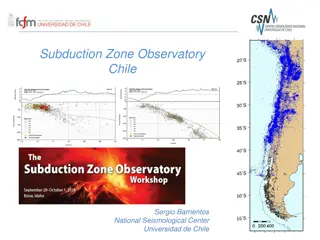Estimation of Earthquake Occurrence Probability Based on Seismological and Ionospheric Precursors
Presentation on estimating earthquake occurrence probability in the Kamchatka region using a combination of seismological and ionospheric precursors. The method involves analyzing mid-term and short-term predictive signs to determine the probability of strong earthquakes. The study discusses the seismological parameter P, ionospheric parameters, and the effectiveness of predictive models.
Download Presentation

Please find below an Image/Link to download the presentation.
The content on the website is provided AS IS for your information and personal use only. It may not be sold, licensed, or shared on other websites without obtaining consent from the author.If you encounter any issues during the download, it is possible that the publisher has removed the file from their server.
You are allowed to download the files provided on this website for personal or commercial use, subject to the condition that they are used lawfully. All files are the property of their respective owners.
The content on the website is provided AS IS for your information and personal use only. It may not be sold, licensed, or shared on other websites without obtaining consent from the author.
E N D
Presentation Transcript
Estimation earthquake occurrence probability in Kamchatka region based on seismological and complex of ionospheric precursors V.V. Bogdanov, A.V. Pavlov Institute of cosmophysical research and radio wave propagation FEB RAS, Paratunka, Russia 1
Introduction In this presentation the authors present the method of estimation of a region, waiting period and probability of strong earthquakes with KS 13.5 (M 6.0) in Kamchatka region based on the combination of mid-term and short-term predictive signs accompanying earthquake formation. The seismological predictive parameter Pwas taken as a mid-term precursor. It was calculated on the basis of the probabilistic model of seismic regime and determines the statistically significant deviations of current probabilities Pk(Si) for seismic events with the energy class KS 9.0 to fall within the zones Sifrom long-term (background) probabilities PT(Si). The expectance zone for an earthquake with KS 13.5 was determined as a group of zones Si, in which seismic regime anomalies were identified by the parameter P. A complex of ionospheric parameters was considered as short-term predictive signs with an earthquake waiting period of up to 5 days. It includes the K-layer, the sporadic Es layer of the r type, the critical frequency foF2, and the frequency stratification of the F2 layer. The probabilities of strong earthquakes with KS 13.5 (M 6.0) that occurred over the period 2019-2021 in an expected zone, determined by the parameter P, were estimated on the basis of Bayes method provided that a complex of anomalous parameters of the ionosphere was identified. 2
Calculation of seismological parameter P . Tk=1 year, dt=1 month, T=01.01.1962 01.06.2021 P 1 seismic calm; P 2 seismic activity; 1< P< 2 background level. 1= 2.5; 2=2.5; Figure 1. Area S= Si, Si= 150 200 km. Figure 2. Temporary values of the parameter Pfor region S2. Red triangles on the time axis indicate earthquakes with KS 13.5. 3
Evaluation of the effectiveness of the prognostic parameter P Table 1. Predictive efficiency of the parameter P. Type of seismic anomaly JG 1.47 JM 0.15 V R Seismic activity ( P 2.5) Seismic calm ( P 2.5) Seismic activity and calm 0.57 0.49 0.51 0.52 2.15 0.28 0.45 0.76 1.47 0.24 Figure 3. The diagram of errors for the parameter Pin predicting earthquakes with KS 13.5 (M 6.0). 4
Method of short-term earthquake prediction based on the complex of ionospheric precursors On the basis of the selected most effective ionospheric precursors, an algorithm for short- term earthquake prediction was constructed, in which a joint analysis of the ionospheric disturbances under consideration is carried out in a sliding time window of width T = 5 days with a step t = 1 day. The condition for announcing the start of the waiting period To seismic event was the execution in a time interval T for at least three of the four ionospheric parameters consider the following criteria: 1) K-layer formation during at least one day of T interval; 2) Formation of sporadic layer Es type r for at least one day interval T; 3) Exceeding the critical frequency foF2 layer F2 median values fmed, calculated for the previous days, not less than 20% ( foF2/fmed 0.2) against the background of the development of the magnetospheric storm (total values of the K-index per day K 20); 4) Stratification of the F2 layer in frequency (mode "V") for at least one day interval T. The waiting period is chosen equal to Tw= 5 days. 5
Table 2. The predictive efficiency of the complex ionospheric precursors for the earthquakes with KS 13.5 (M 6.0) in time interval 01.01.2013-01.06.2021. n(AE) 21 n(A) 180 N+ 24 N 30 JG 1.69 JM 0.33 V R 0.1 0.8 0.47 0.2 Figure 3. The diagram of errors for the method of the complex ionospheric precursors for KS 13.5 (M 6.0). The lower bounds of the confidence interval of the random forecast with the significance level are marked =0.01 and =0.05. 6
Estimation earthquake occurrence probability based on seismological and ionospheric precursors ( ) I ( | + ) ( | ) P D P E D P I D 1 1 1 E = ( | ) P D EI 1 ( ) ( | ) ( | ) ( ) ( | ) ( | ) P D P E D P D P D P D P I D 1 1 1 2 2 2 E the occurrence of anomalous values of the parameter P; I the occurrence of complex of the and ionospheric precursors; D1 an earthquake the occurrence predicted energy class KSin the area Sexp; D2 absence earthquake with energy class KSin the area Sexp; P(D1) the probability of occurrence of earthquake with predicted energy class KSin the area Sexp; P(D2) the probability of absence earthquake with predicted energy class KSin the area Sexp; P(E|D1) the probability of occurrence of earthquake with predicted energy class KSin the area Sexp when identifying anomalies of the seismic regime (activation or calm); P(E|D2) the probability of absence earthquake with predicted energy class KSin the area Sexp when identifying anomalies of the seismic regime P(I|D1) the probability of occurrence of earthquake with predicted energy class KSin the area Sexp when identifying complex of ionospheric precursors; P(I|D2) the probability of occurrence of complex of ionospheric precursors, after which the earthquake with predicted energy class KSin the area Sexpdid not occur. P(D1|EI) the probability of occurrence of earthquake with predicted energy class KSin the area Sexpwhen identifying anomalies of the seismic regime (event E) and complex of ionospheric precursors (event I ). 7
The results of applying the method for predicting earthquakes with KS13.5 Table 3. List of predicted earthquakes with energy class KS 13.5 (M 6.0) over period 01.01.2019 01.06.2021. T 2019.06.21 2019.06.26 2019.06.21 2019.06.26 2020.01.21 2020.02.05 2020.02.11 2020.02.29 2020.03.19 2020.03.28 2021.02.14 2020.03.30 Date EQ h, km P(D1|EI) KS Sexp 1 2 3 4 5 6 2019.06.25 09:05:39 2019.06.26 02:18:06 2020.01.22 11:04:11 2020.02.20 18:57:34 2020.03.25 02:49:19 2021.03.16 18:38:21 14.3 14.4 14.3 14.3 16.8 14.6 57 53 83 52 48 64 0.69 0.69 0.71 0.72 0.73 0.74 + + + + + + a) b) c) Figure 4. Maps of expectation earthquakes with energy class KS 13.5: a) 2021.03.20, KS=14.6; b) 2020.03.25, KS=16.8; c) 2021.03.16, KS=14.6. 8
Evaluation of the effectiveness of the method based on seismological and ionospheric precursors Levels of conditional probability P(D1|EI) 0.5 0.7 JG JM V R 0.09 0.09 1 1.8 1.52 0.44 0.23 0.67 a) b) Figure 5. The diagram of errors for the method for predicting earthquakes with KS 13.5 (M 6.0) based on seismological and complex of ionospheric precursors at a given level of values of the conditional probability of earthquake occurrence P(D1|EI)=0.5 (a) and P(D1|EI)=0.7 (b). 9
Conclusion An approach is presented that combines seismological and ionospheric prognostic signs in order to assess the probability of occurrence of earthquakes with KS 13.5 (M 6.0) in the Kamchatka region. A retrospective analysis was carried out using this technique for the time period 01.01.2019 01.06.2021. The effectiveness of method for determining the area and possible period of the onset of seismic events with KS 13.5 in the joint analysis of the seismic parameter Pand the complex of ionospheric precursors (at the values of the conditional probability of the onset of earthquakes P(D1|EI) 0.5 and P(D1|EI) 0.7) shows that the forecast using this method is more than 1.5 times different from a random guess. The low reliability of the V forecast may be due to the fact that, ionospheric disturbances are formed against the background of solar activity, and it is not yet possible to accurately indicate the lower threshold of the earthquake magnitude, the preparation of which is already beginning to influence the state of the ionosphere. Seismic events with an energy class KS 13.5 predicted by ionospheric precursors and taken into account in statistics do not include events with an energy class KS<13.5, although the ionospheric precursor has formed. Consequently, the ionospheric forecast signs that precede seismic events with KS<13.5 are false for events with KS 13.5, thereby lowering the forecast reliability. 10
